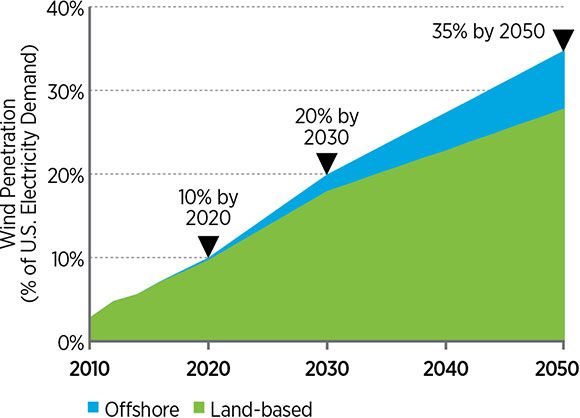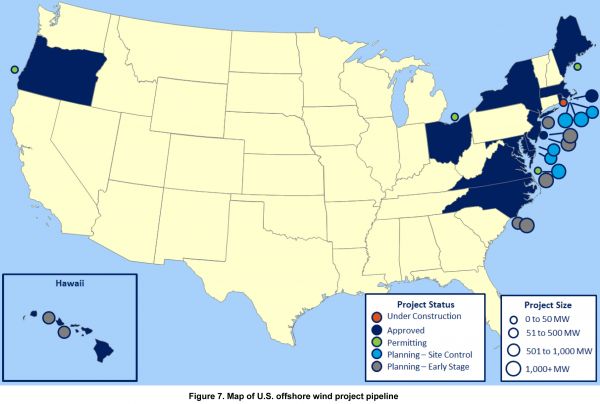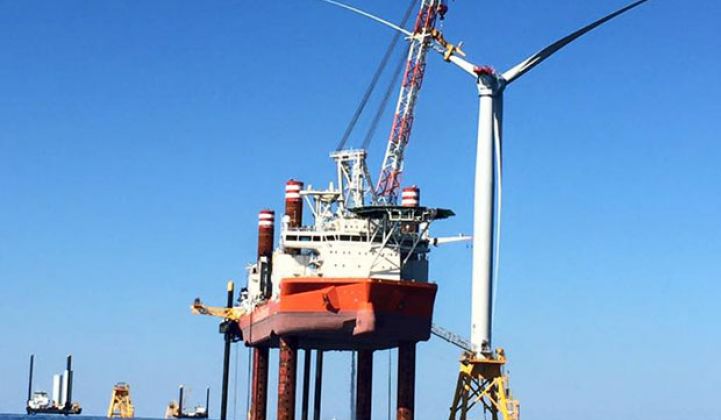There are more than 70 gigawatts of wind power installed across the U.S., but despite the country's vast coastlines, all of that sits on land.
That is going to change this year. Deepwater Wind just installed the first turbines atop the Block Island Wind Farm’s five towers. Construction is expected to wrap up in early September, and the 30-megawatt project is expected to be operational in fall. It will be the first offshore wind farm in the U.S.
By 2020, the U.S. Department of Energy expects about 10 percent of U.S. electricity demand will be served by wind, but only a sliver of that will be offshore.

Source: U.S. Department of Energy
That is expected to finally change in the coming decade, even if offshore wind will never come close to reaching the penetration of onshore wind in the U.S. The Northeast and mid-Atlantic regions are in the lead, according to data from the American Wind Energy Association’s U.S. Wind Industry Annual Market Report, Year Ending 2015.
At the end of last year, the AWEA had identified 11 offshore wind energy projects under active development. The U.S. DOE says there are more than 20 projects in various stages of development with a potential of about 15 gigawatts, based on current leases.

Source: U.S. Department of Energy
Many of the projects have faced stumbling blocks and opposition and have never fully launched. In the waters off of Delaware, there is a lone wind turbine where originally 150 were planned to be installed. Cape Wind, which has been mired in difficulties for a decade, was issued another setback in August when it was shut out of Massachusetts’ offshore wind legislation.
But the tide may finally be turning for U.S. offshore wind. New York’s Governor Andrew Cuomo has called for an offshore wind master plan, and earlier this year, the U.S. Department of Interior's Bureau of Ocean Energy Management announced it would hold an auction for an energy lease 11 miles off the coast of Long Island. The 81,000-acre site could host approximately 700 megawatts of wind, which would rival some of the largest offshore wind farms in the waters off of Europe. At the beginning of this week, Massachusetts set a target of 1.6 gigawatts of contracted offshore wind by 2027.
"With this latest legislation out of Massachusetts, the U.S. is moving ahead with offshore wind at a large scale. But there will be barriers to securing cost-effective wind farms,” said Tom Harries, wind analyst with Bloomberg New Energy Finance. “As we know, building Block Island took ages -- twice as long as it should. The lack of a domestic supply and the restrictive Marine Act will not only delay construction but also significantly add to costs." Meanwhile, Europe's robust offshore wind industry is on track to slash the levelized cost of offshore wind energy 40 percent from 2010 levels by 2020.
Even if the current projects in development all move forward given the cost and regulatory barriers, the U.S. will continue to be a laggard in offshore wind. By 2020, Bloomberg New Energy Finance forecasts there will be about 99 megawatts of offshore wind in the U.S., although that jumps to more than 2,500 megawatts by 2026. By contrast, the U.S. DOE estimates there will be 47,000 megawatts of global offshore wind by 2020.



